warning Citroen C3 PICASSO RHD 2011.5 1.G Owner's Guide
[x] Cancel search | Manufacturer: CITROEN, Model Year: 2011.5, Model line: C3 PICASSO RHD, Model: Citroen C3 PICASSO RHD 2011.5 1.GPages: 244, PDF Size: 8.29 MB
Page 101 of 244
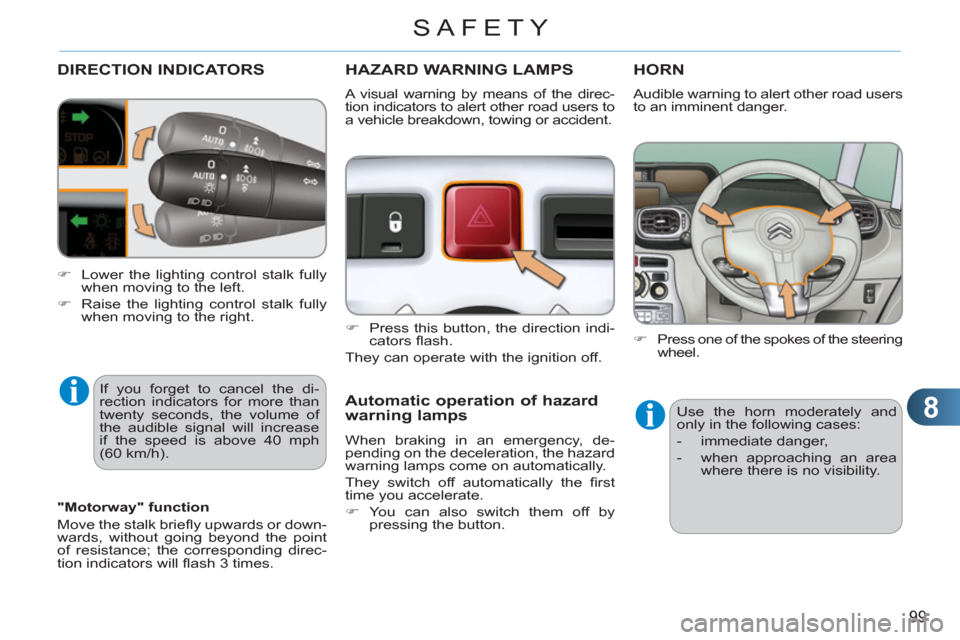
8
99
SAFETY
DIRECTION INDICATORS
If you forget to cancel the di-
rection indicators for more than
twenty seconds, the volume of
the audible signal will increase
if the speed is above 40 mph
(60 km/h).
HAZARD WARNING LAMPS
�)
Press this button, the direction indi-
cators fl ash.
They can operate with the ignition off.
Automatic operation of hazard
warning lamps
When braking in an emergency, de-
pending on the deceleration, the hazard
warning lamps come on automatically.
They switch off automatically the fi rst
time you accelerate.
�)
You can also switch them off by
pressing the button.
HORN
�)
Press one of the spokes of the steering
wheel.
Use the horn moderately and
only in the following cases:
- immediate danger,
- when approaching an area
where there is no visibility.
Audible warning to alert other road users
to an imminent danger.
"Motorway" function
Move the stalk briefl y upwards or down-
wards, without going beyond the point
of resistance; the corresponding direc-
tion indicators will fl ash 3 times.
A visual warning by means of the direc-
tion indicators to alert other road users to
a vehicle breakdown, towing or accident.
�)
Lower the lighting control stalk fully
when moving to the left.
�)
Raise the lighting control stalk fully
when moving to the right.
Page 102 of 244
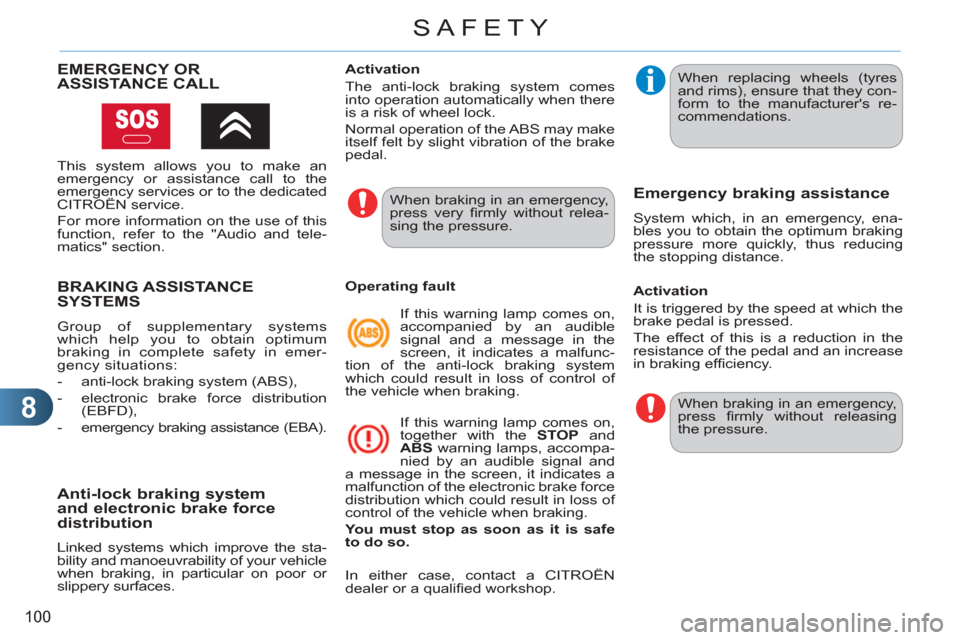
8
100
SAFETY
BRAKING ASSISTANCE
SYSTEMS
Group of supplementary systems
which help you to obtain optimum
braking in complete safety in emer-
gency situations:
- anti-lock braking system (ABS),
- electronic brake force distribution
(EBFD),
- emergency braking assistance (EBA).
Anti-lock braking systemand electronic brake force
distribution
Linked systems which improve the sta-
bility and manoeuvrability of your vehicle
when braking, in particular on poor or
slippery surfaces.
When braking in an emergency,
press very fi rmly without relea-
sing the pressure.
When replacing wheels (tyres
and rims), ensure that they con-
form to the manufacturer's re-
commendations.
Operating fault
If this warning lamp comes on,
accompanied by an audible
signal and a message in the
screen, it indicates a malfunc-
tion of the anti-lock braking system
which could result in loss of control of
the vehicle when braking.
If this warning lamp comes on,
together with the STOP
and
ABS
warning lamps, accompa-
nied by an audible signal and
a message in the screen, it indicates a
malfunction of the electronic brake force
distribution which could result in loss of
control of the vehicle when braking.
You must stop as soon as it is safe
to do so.
Emergency braking assistance
System which, in an emergency, ena-
bles you to obtain the optimum braking
pressure more quickly, thus reducing
the stopping distance.
Activation
The anti-lock braking system comes
into operation automatically when there
is a risk of wheel lock.
Normal operation of the ABS may make
itself felt by slight vibration of the brake
pedal.
Activation
It is triggered by the speed at which the
brake pedal is pressed.
The effect of this is a reduction in the
resistance of the pedal and an increase
in braking effi ciency.
In either case, contact a CITROËN
dealer or a qualifi ed workshop. When braking in an emergency,
press fi rmly without releasing
the pressure.
EMERGENCY OR
ASSISTANCE CALL
This system allows you to make an
emergency or assistance call to the
emergency services or to the dedicated
CITROËN service.
For more information on the use of this
function, refer to the "Audio and tele-
matics" section.
Page 103 of 244
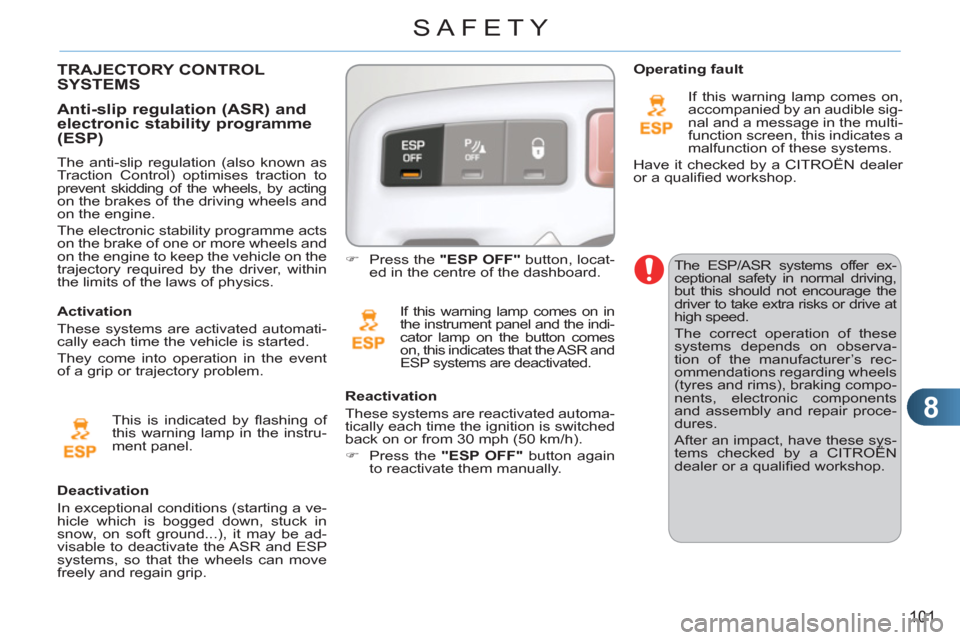
8
101
SAFETY
The ESP/ASR systems offer ex-
ceptional safety in normal driving,
but this should not encourage the
driver to take extra risks or drive at
high speed.
The correct operation of these
systems depends on observa-
tion of the manufacturer’s rec-
ommendations regarding wheels
(tyres and rims), braking compo-
nents, electronic components
and assembly and repair proce-
dures.
After an impact, have these sys-
tems checked by a CITROËN
dealer or a qualifi ed workshop.
Deactivation
In exceptional conditions (starting a ve-
hicle which is bogged down, stuck in
snow, on soft ground...), it may be ad-
visable to deactivate the ASR and ESP
systems, so that the wheels can move
freely and regain grip.
�)
Press the "ESP OFF"
button, locat-
ed in the centre of the dashboard.
If this warning lamp comes on in
the instrument panel and the indi-
cator lamp on the button comes
on, this indicates that the ASR and
ESP systems are deactivated.
Reactivation
These systems are reactivated automa-
tically each time the ignition is switched
back on or from 30 mph (50 km/h).
�)
Press the "ESP OFF"
button again
to reactivate them manually.
Operating fault
If this warning lamp comes on,
accompanied by an audible sig-
nal and a message in the multi-
function screen, this indicates a
malfunction of these systems.
Have it checked by a CITROËN dealer
or a qualifi ed workshop.
TRAJECTORY CONTROLSYSTEMS
The anti-slip regulation (also known as
Traction Control) optimises traction to
prevent skidding of the wheels, by acting
on the brakes of the driving wheels and
on the engine.
The electronic stability programme acts
on the brake of one or more wheels and
on the engine to keep the vehicle on the
trajectory required by the driver, within
the limits of the laws of physics.
Anti-slip regulation (ASR) and
electronic stability programme (ESP)
This is indicated by fl ashing of
this warning lamp in the instru-
ment panel.
Activation
These systems are activated automati-
cally each time the vehicle is started.
They come into operation in the event
of a grip or trajectory problem.
Page 104 of 244

8
102
SAFETY
Height adjustment
Seat belt not fastened/unfastened
warning lamp
Fastening
�)
Pull the strap, then insert the tongue
in the buckle.
�)
Check that the seat belt is fastened
correctly by pulling the strap.
�)
To lower the attachment point,
squeeze the control A
and slide it
downwards.
�)
To raise the attachment point, slide
the control A
upwards.
When the ignition is switched
on, this warning lamp comes on,
either on the instrument panel
or on the seat belt and passen-
ger’s front airbag warning lamp display,
if the driver and/or the front passenger
has not fastened their seat belt.
From approximately 12 mph (20 km/h)
this warning lamp fl ashes for two mi-
nutes accompanied by an audible sig-
nal. Once these two minutes have
elapsed, this warning lamp remains on
until the driver and/or the front passen-
ger fastens their seat belt.
Unfastening
�)
Press the red button on the buckle.
�)
Guide the seat belt as it rolls up.
SEAT BELTS
Front seat belts
The front seat belts are fi tted with a pre-
tensioning and force limiting system.
This system improves safety in the front
seats in the event of a front or side im-
pact. Depending on the severity of the
impact, the pretensioning system in-
stantly tightens the seat belts against
the body of the occupants.
The pretensioning seat belts are active
when the ignition is on.
The force limiter reduces the pressure
of the seat belt on the chest of the occu-
pant, so improving their protection.
Page 105 of 244

8
103
SAFETY
1.
Front and/or rear seat belts not
fastened/unfastened warning lamp.
2.
Front left seat belt warning lamp.
3.
Front right seat belt warning lamp.
4.
Rear right seat belt warning lamp.
5.
Rear centre seat belt warning lamp.
6.
Rear left seat belt warning lamp.
Seat belt not fastened/unfastened
warning lamp display
Rear seat belts
The rear seats are each fi tted with a
three-point inertia reel seat belt with
force limiter (with the exception of the
rear centre seat).
Locking
When the rear side side belts are not being
used, you can lock them in place. To do so:
�)
Raise the grip A
to its maximum
height.
Fastening
�)
Pull the strap, then insert the tongue
in the buckle.
�)
Check that the seat belt is fastened
correctly by pulling the strap.
Unfastening
�)
Press the red button on the buckle.
�)
Guide the seat belt as it rolls up.
The corresponding warning lamp 2
or 3
comes on in red on the seat belt and
passenger’s front airbag warning lamp
display if the seat belt is not fastened or
is unfastened.
Seat belt unfastened warning lamp
This warning lamp comes on,
either on the instrument panel
or on the seat belt and passen-
ger’s front airbag warning lamp
display, when one or more rear passen-
gers unfasten their seat belt.
From approximately 12 mph (20 km/h), this
warning lamp fl ashes for two minutes accom-
panied by an audible signal of increasing vol-
ume. Once these two minutes have elapsed,
this warning lamp remains on until the one or
more rear passengers fasten their seat belt.
Seat belt unfastened warning lamp
display
When the ignition is switched on, the cor-
responding warning lamps 4
, 5
and 6
come
on in red for approximately 30 seconds, if
the seat belt is not fastened.
When the engine is running or the vehicle
is moving, the corresponding warning lamp
4
, 5
or 6
comes on in red, accompanied
by an audible signal and a message on the
multifunction screen, if a rear passenger
has unfastened their seat belt.
Page 107 of 244
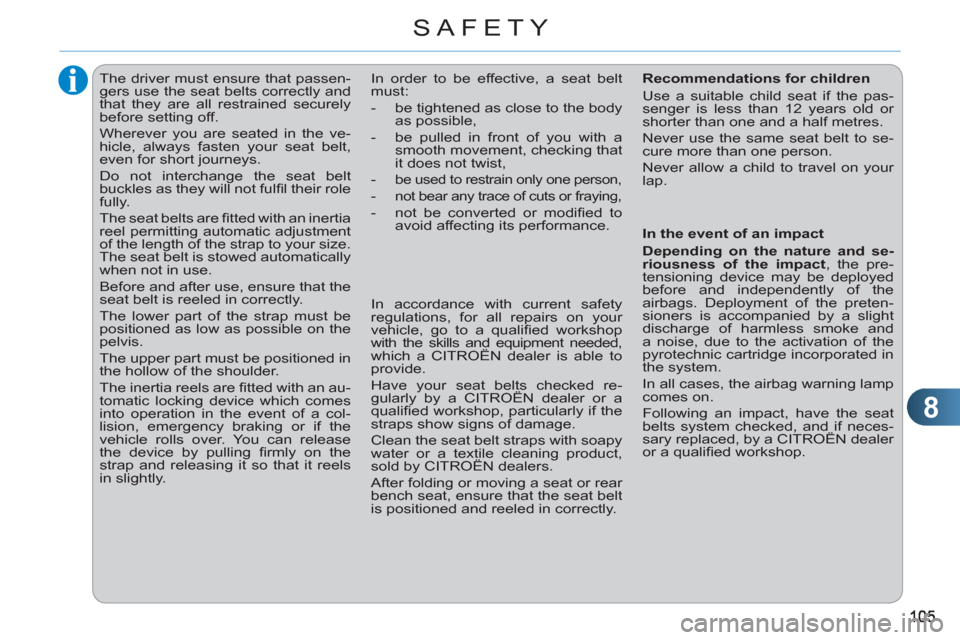
8
SAFETY
The driver must ensure that passen-
gers use the seat belts correctly and
that they are all restrained securely
before setting off.
Wherever you are seated in the ve-
hicle, always fasten your seat belt,
even for short journeys.
Do not interchange the seat belt
buckles as they will not fulfi l their role
fully.
The seat belts are fi tted with an inertia
reel permitting automatic adjustment
of the length of the strap to your size.
The seat belt is stowed automatically
when not in use.
Before and after use, ensure that the
seat belt is reeled in correctly.
The lower part of the strap must be
positioned as low as possible on the
pelvis.
The upper part must be positioned in
the hollow of the shoulder.
The inertia reels are fi tted with an au-
tomatic locking device which comes
into operation in the event of a col-
lision, emergency braking or if the
vehicle rolls over. You can release
the device by pulling fi rmly on the
strap and releasing it so that it reels
in slightly. In order to be effective, a seat belt
must:
- be tightened as close to the body
as possible,
- be pulled in front of you with a
smooth movement, checking that
it does not twist,
-
be used to restrain only one person,
- not bear any trace of cuts or fraying,
- not be converted or modifi ed to
avoid affecting its performance.
In accordance with current safety
regulations, for all repairs on your
vehicle, go to a qualifi ed workshop
with the skills and equipment needed,
which a CITROËN dealer is able to
provide.
Have your seat belts checked re-
gularly by a CITROËN dealer or a
qualifi ed workshop, particularly if the
straps show signs of damage.
Clean the seat belt straps with soapy
water or a textile cleaning product,
sold by CITROËN dealers.
After folding or moving a seat or rear
bench seat, ensure that the seat belt
is positioned and reeled in correctly.
Recommendations for children
Use a suitable child seat if the pas-
senger is less than 12 years old or
shorter than one and a half metres.
Never use the same seat belt to se-
cure more than one person.
Never allow a child to travel on your
lap.
In the event of an impact
Depending on the nature and se-
riousness of the impact
, the pre-
tensioning device may be deployed
before and independently of the
airbags. Deployment of the preten-
sioners is accompanied by a slight
discharge of harmless smoke and
a noise, due to the activation of the
pyrotechnic cartridge incorporated in
the system.
In all cases, the airbag warning lamp
comes on.
Following an impact, have the seat
belts system checked, and if neces-
sary replaced, by a CITROËN dealer
or a qualifi ed workshop.
Page 109 of 244
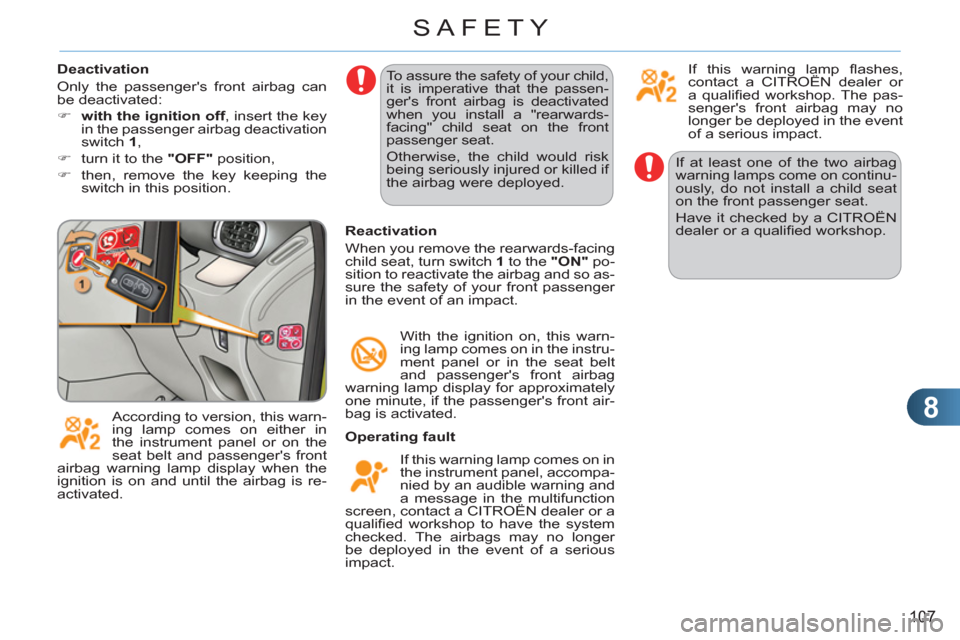
8
107
SAFETY
If at least one of the two airbag
warning lamps come on continu-
ously, do not install a child seat
on the front passenger seat.
Have it checked by a CITROËN
dealer or a qualifi ed workshop.
Operating fault
If this warning lamp comes on in
the instrument panel, accompa-
nied by an audible warning and
a message in the multifunction
screen, contact a CITROËN dealer or a
qualifi ed workshop to have the system
checked. The airbags may no longer
be deployed in the event of a serious
impact.
Reactivation
When you remove the rearwards-facing
child seat, turn switch 1
to the "ON"
po-
sition to reactivate the airbag and so as-
sure the safety of your front passenger
in the event of an impact.
With the ignition on, this warn-
ing lamp comes on in the instru-
ment panel or in the seat belt
and passenger's front airbag
warning lamp display for approximately
one minute, if the passenger's front air-
bag is activated. To assure the safety of your child,
it is imperative that the passen-
ger's front airbag is deactivated
when you install a "rearwards-
facing" child seat on the front
passenger seat.
Otherwise, the child would risk
being seriously injured or killed if
the airbag were deployed.
According to version, this warn-
ing lamp comes on either in
the instrument panel or on the
seat belt and passenger's front
airbag warning lamp display when the
ignition is on and until the airbag is re-
activated. If this warning lamp fl ashes,
contact a CITROËN dealer or
a qualifi ed workshop. The pas-
senger's front airbag may no
longer be deployed in the event
of a serious impact.
Deactivation
Only the passenger's front airbag can
be deactivated:
�)
with the ignition off
, insert the key
in the passenger airbag deactivation
switch 1
,
�)
turn it to the "OFF"
position,
�)
then, remove the key keeping the
switch in this position.
Page 110 of 244
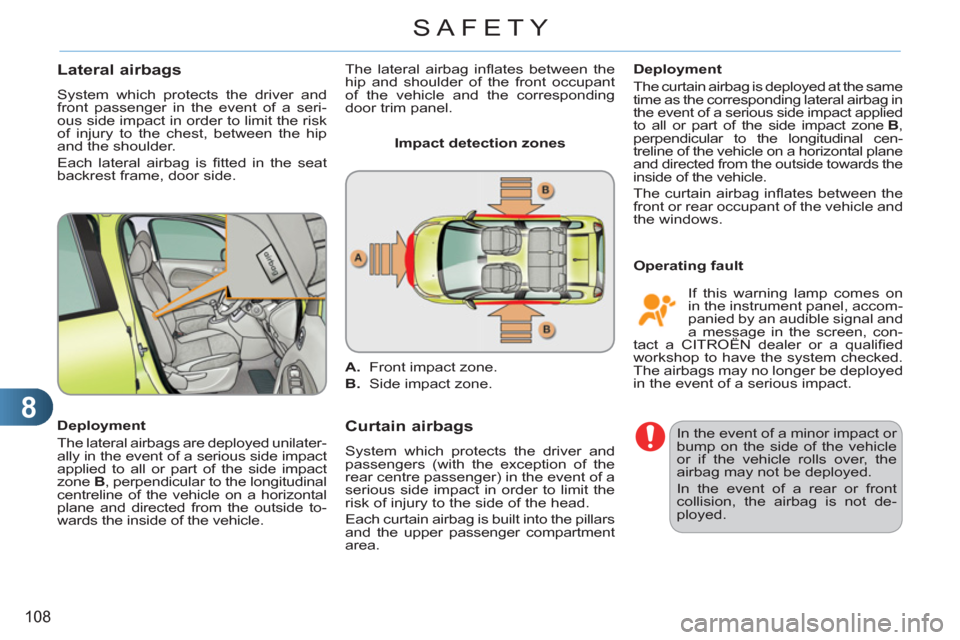
8
108
SAFETY
Lateral airbags
System which protects the driver and
front passenger in the event of a seri-
ous side impact in order to limit the risk
of injury to the chest, between the hip
and the shoulder.
Each lateral airbag is fi tted in the seat
backrest frame, door side.
Deployment
The lateral airbags are deployed unilater-
ally in the event of a serious side impact
applied to all or part of the side impact
zone B
, perpendicular to the longitudinal
centreline of the vehicle on a horizontal
plane and directed from the outside to-
wards the inside of the vehicle.
Curtain airbags
System which protects the driver and
passengers (with the exception of the
rear centre passenger) in the event of a
serious side impact in order to limit the
risk of injury to the side of the head.
Each curtain airbag is built into the pillars
and the upper passenger compartment
area.
Operating fault
Deployment
The curtain airbag is deployed at the same
time as the corresponding lateral airbag in
the event of a serious side impact applied
to all or part of the side impact zone B
,
perpendicular to the longitudinal cen-
treline of the vehicle on a horizontal plane
and directed from the outside towards the
inside of the vehicle.
The curtain airbag infl ates between the
front or rear occupant of the vehicle and
the windows.
In the event of a minor impact or
bump on the side of the vehicle
or if the vehicle rolls over, the
airbag may not be deployed.
In the event of a rear or front
collision, the airbag is not de-
ployed.
Impact detection zones
A.
Front impact zone.
B.
Side impact zone.
If this warning lamp comes on
in the instrument panel, accom-
panied by an audible signal and
a message in the screen, con-
tact a CITROËN dealer or a qualifi ed
workshop to have the system checked.
The airbags may no longer be deployed
in the event of a serious impact. The lateral airbag infl ates between the
hip and shoulder of the front occupant
of the vehicle and the corresponding
door trim panel.
Page 112 of 244
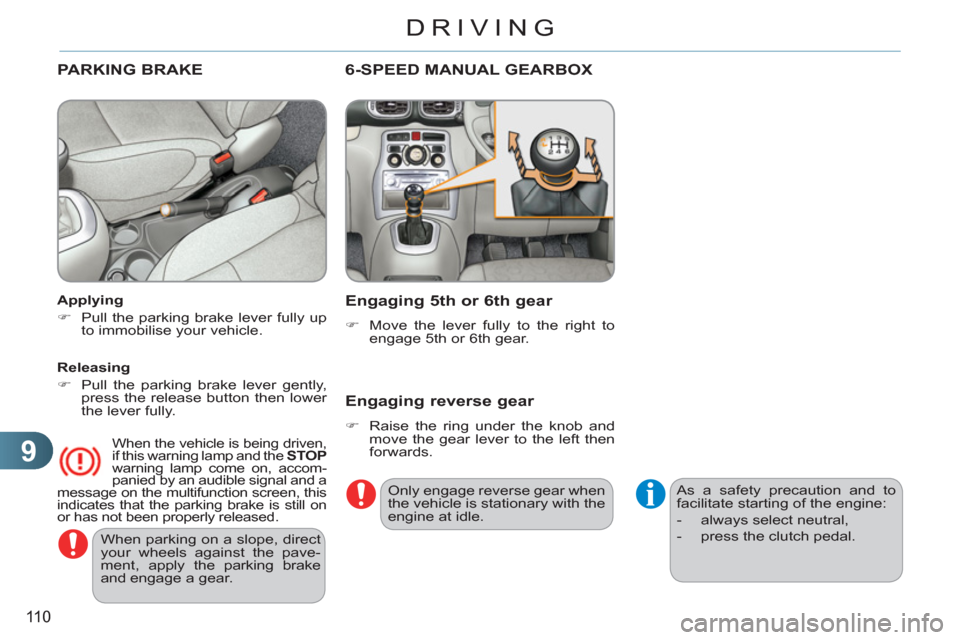
9
110
DRIVING
When parking on a slope, direct
your wheels against the pave-
ment, apply the parking brake
and engage a gear.
PARKING BRAKE
Applying
�)
Pull the parking brake lever fully up
to immobilise your vehicle.
When the vehicle is being driven,
if this warning lamp and the STOP
warning lamp come on, accom-
panied by an audible signal and a
message on the multifunction screen, this
indicates that the parking brake is still on
or has not been properly released.
Releasing
�)
Pull the parking brake lever gently,
press the release button then lower
the lever fully.
6-SPEED MANUAL GEARBOX
En
gaging 5th or 6th gear
�)
Move the lever fully to the right to
engage 5th or 6th gear.
Engaging reverse gear
�)
Raise the ring under the knob and
move the gear lever to the left then
forwards.
Only engage reverse gear when
the vehicle is stationary with the
engine at idle. As a safety precaution and to
facilitate starting of the engine:
- always select neutral,
- press the clutch pedal.
Page 117 of 244
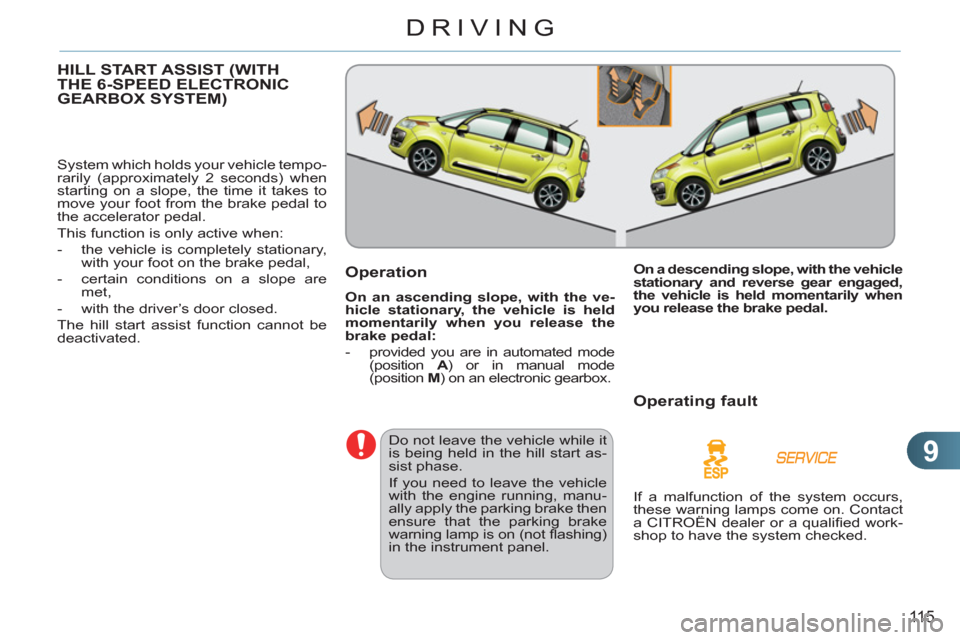
9
115
DRIVING
HILL START ASSIST (WITH THE 6-SPEED ELECTRONIC GEARBOX SYSTEM)
System which holds your vehicle tempo-
rarily (approximately 2 seconds) when
starting on a slope, the time it takes to
move your foot from the brake pedal to
the accelerator pedal.
This function is only active when:
- the vehicle is completely stationary,
with your foot on the brake pedal,
- certain conditions on a slope are
met,
- with the driver’s door closed.
The hill start assist function cannot be
deactivated.
Operation
On an ascending slope, with the ve-
hicle stationary, the vehicle is held
momentarily when you release the
brake pedal:
- provided you are in automated mode
(position A
) or in manual mode
(position M
) on an electronic gearbox.
Do not leave the vehicle while it
is being held in the hill start as-
sist phase.
If you need to leave the vehicle
with the engine running, manu-
ally apply the parking brake then
ensure that the parking brake
warning lamp is on (not fl ashing)
in the instrument panel.
On a descending slope, with the vehicle
stationary and reverse gear engaged,
the vehicle is held momentarily when
you release the brake pedal.
Operating fault
If a malfunction of the system occurs,
these warning lamps come on. Contact
a CITROËN dealer or a qualifi ed work-
shop to have the system checked.